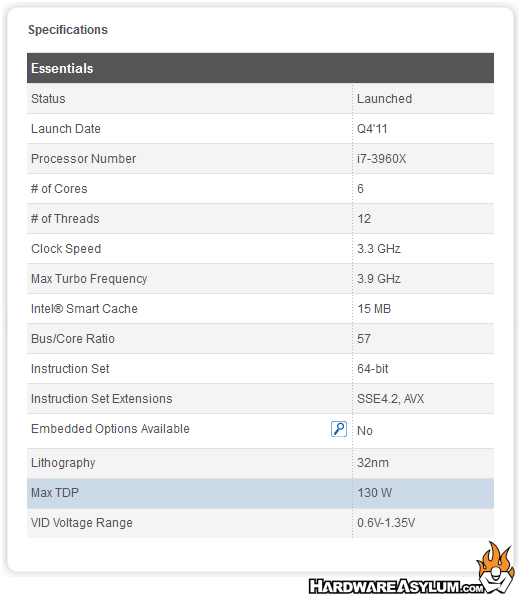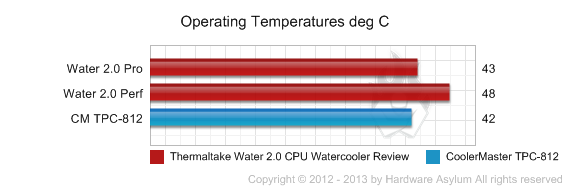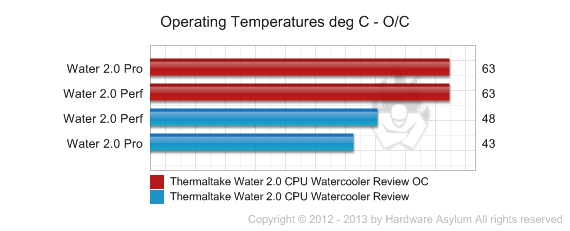Thermaltake Water 2.0 CPU Watercooler Review
Author: Dennis Garcia
Published: Friday, June 01, 2012
Benchmarks
The Thermaltake Water 2.0 Watercooling system is designed for Intel Socket LGA 2011 / 1366 / 1156 / 1155 / 775 and Athlon 64. Here is an overview of the system and testing methodology.
The system as it was tested
Asus P9X79 - X79 Chipset
Intel Core i7 3960x (3.3Ghz) Hex Core 6 x 256KB L2 Cache 15MB L3 Cache
Thermaltake Water 2.0 Pro
Thermaltake Water 2.0 Performer
Cooler Master TPC 812
All coolers are equipped with dual 120mm fans running with the Turbo PWM fan profile.
The CPUID System Monitor was used to obtain and record system temperature data and being that this is a quad core processor we need something that will work across all of the cores at once. For this task we're using a new version of Prime95 (p95v255a) that will allow you to spawn (n) instances to test with.
Intel Core i7 3960x (3.3Ghz) Hex Core 6 x 256KB L2 Cache 15MB L3 Cache
Thermaltake Water 2.0 Pro
Thermaltake Water 2.0 Performer
Cooler Master TPC 812
All coolers are equipped with dual 120mm fans running with the Turbo PWM fan profile.
The CPUID System Monitor was used to obtain and record system temperature data and being that this is a quad core processor we need something that will work across all of the cores at once. For this task we're using a new version of Prime95 (p95v255a) that will allow you to spawn (n) instances to test with.

Editors note: Even though the Windows 7 task manager reported 100% processor usage we could never attain a 100% of the rated heat output as documented by Intel (see above) when using Prime95 as a basis for that heat production. Knowing this we ran the stress test until the maximum temperature was attainted and stabilized.
Other things to consider when judging software induced heat output.
a) Clock throttling by the processor at high temperatures.
b) Normal software isn't designed to produce maximum heat output.
c) Variances of cooling temperature.
d) Variances in CPU load.
e) Inaccuracies in thermal diode readouts.
Of course the list goes on..
Our testing methodology is aimed to provide a real world look into this heatsink given the test system provided.
Other things to consider when judging software induced heat output.
a) Clock throttling by the processor at high temperatures.
b) Normal software isn't designed to produce maximum heat output.
c) Variances of cooling temperature.
d) Variances in CPU load.
e) Inaccuracies in thermal diode readouts.
Of course the list goes on..
Our testing methodology is aimed to provide a real world look into this heatsink given the test system provided.
Default Speed

A C/W rating can quickly be calculated using this formula.
C/W = (CPU temp - Ambient temp)/(Variance(%) * CPU Watts)
Allowed variance for this test = 85%
CPU Watts = 130W
Pro - 0.16 C/W = (43C - 25C)/(.85(130W))
Perf - 0.21 C/W = (48C - 25C)/(.85(130W))
C/W = (CPU temp - Ambient temp)/(Variance(%) * CPU Watts)
Allowed variance for this test = 85%
CPU Watts = 130W
Pro - 0.16 C/W = (43C - 25C)/(.85(130W))
Perf - 0.21 C/W = (48C - 25C)/(.85(130W))
Overclocked
For this next test the CPU speed was cranked up to 4.6Ghz and the test was re-run.

To calculate a new C/W rating for this test we will need to factor in the increased processor wattage. The formula and constants for this are listed below.
ocC/W = dCPU Watts * (ocMhz / dMhz) * (ocVcore / dVcore)2
ocMhz = 4600
dMhz = 3300
ocVcore = 1.375
dVcore = 1.2
The variance still applies for our C/W calculation
Allowed variance for this test = 85%
CPU Watts = 238W
Pro - 0.19 C/W = (63C - 25C)/(.85(238W))
Perf - 0.19 C/W = (63C - 25C)/(.85(238W))
ocC/W = dCPU Watts * (ocMhz / dMhz) * (ocVcore / dVcore)2
ocMhz = 4600
dMhz = 3300
ocVcore = 1.375
dVcore = 1.2
The variance still applies for our C/W calculation
Allowed variance for this test = 85%
CPU Watts = 238W
Pro - 0.19 C/W = (63C - 25C)/(.85(238W))
Perf - 0.19 C/W = (63C - 25C)/(.85(238W))
Benchmark Conclusion
In our heatsink and waterblock tests we don't really focus on overall load temperatures but rather how well the product can remove heat given a specified heat load. Since this is a real world testing method we need to take into consideration real world variables and estimate tolerances. This is why we normally only apply 85% of the total wattage output to our heat calculations.
The resulting C/W number is used to rate how efficient a heatsink or waterblock is based on the given heat load. These numbers can be used to determine heat capacity, the larger the difference the less efficient the heatsink is. (aka not good for overclocking)
There are some very interesting things going on with these two coolers. First you will notice a radical change between the stock speed C/W numbers giving preference to the Pro cooler with the larger radiator. You would expect this given that there is more surface area and more liquid available. What we found interesting is that this change didn't carry thru to the overclocking tests. Both coolers have identical load temperatures and C/W ratings.
So, what went wrong?
Simply put, this is a capacity issue. Looking at the Water 2.0 Performance cooler we see that the C/W is basically the same between the two tests. This tells us that this cooler can handle the current heat load, and maybe a little more, before things start to collapse. The problem is that while the Water 2.0 Pro cooler does have a higher capacity the fans are not powerful enough to move adequate air thru the thicker radiator to maintain the C/W rating. The simple solution is plan on replacing the fans if you happen to buy a Pro version.
You will notice that we didn't include a stock or low powered air cooler in this review but used the Cooler Master TPC-812 performance heatsink featuring Vapor Chamber technology. To make the tests "fair" we added a secondary stock fan to this cooler and loaded it up for the default speed tests. The results speak for themselves and posted the lowest overall load temperature at 42c.
Keep in mind these calculations are provided for demonstration purposes only and may not reflect the actual lab tested C/W rating, but we're pretty close.
The resulting C/W number is used to rate how efficient a heatsink or waterblock is based on the given heat load. These numbers can be used to determine heat capacity, the larger the difference the less efficient the heatsink is. (aka not good for overclocking)
There are some very interesting things going on with these two coolers. First you will notice a radical change between the stock speed C/W numbers giving preference to the Pro cooler with the larger radiator. You would expect this given that there is more surface area and more liquid available. What we found interesting is that this change didn't carry thru to the overclocking tests. Both coolers have identical load temperatures and C/W ratings.
So, what went wrong?
Simply put, this is a capacity issue. Looking at the Water 2.0 Performance cooler we see that the C/W is basically the same between the two tests. This tells us that this cooler can handle the current heat load, and maybe a little more, before things start to collapse. The problem is that while the Water 2.0 Pro cooler does have a higher capacity the fans are not powerful enough to move adequate air thru the thicker radiator to maintain the C/W rating. The simple solution is plan on replacing the fans if you happen to buy a Pro version.
You will notice that we didn't include a stock or low powered air cooler in this review but used the Cooler Master TPC-812 performance heatsink featuring Vapor Chamber technology. To make the tests "fair" we added a secondary stock fan to this cooler and loaded it up for the default speed tests. The results speak for themselves and posted the lowest overall load temperature at 42c.
Keep in mind these calculations are provided for demonstration purposes only and may not reflect the actual lab tested C/W rating, but we're pretty close.

